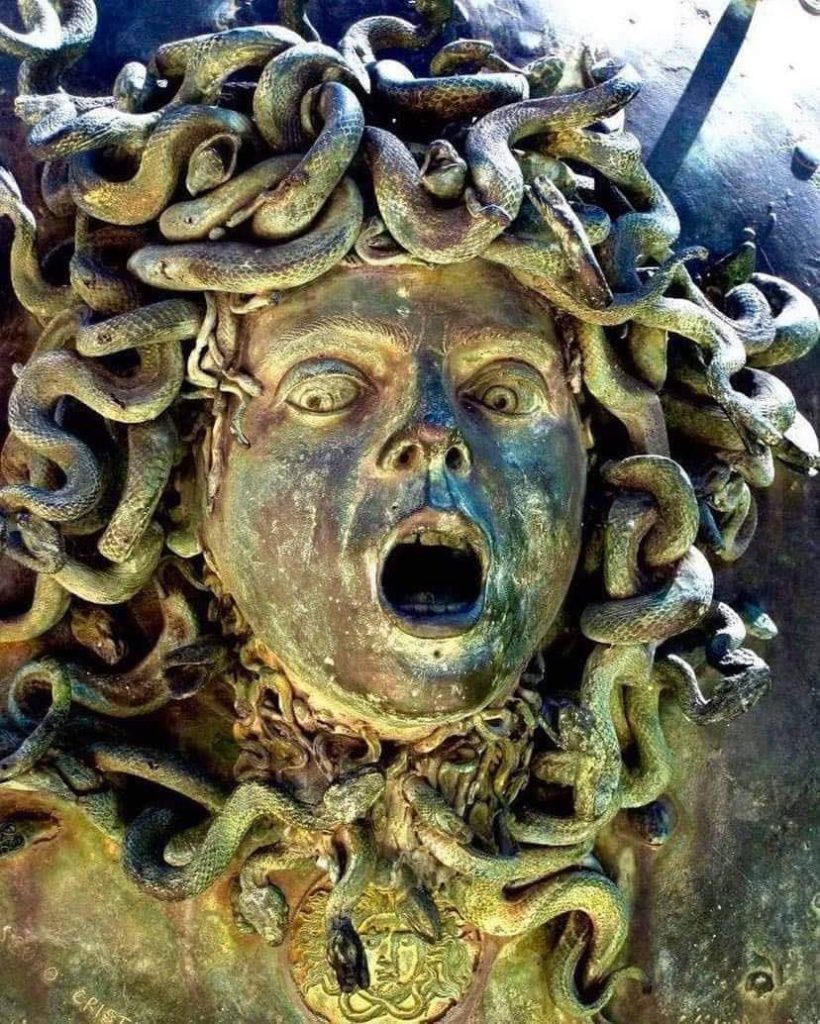Hadrian’s Villa, a sprawling testament to Roman ingenuity and cultural synthesis, lies nestled in the verdant landscapes near Tivoli, Italy. This UNESCO World Heritage Site, once the private retreat of Emperor Hadrian, stands as an enduring symbol of Rome’s architectural and artistic grandeur. Recently, this historical treasure trove has yielded a fascinating new discovery—an exquisitely crafted bronze head of Medusa. This remarkable artifact has reignited scholarly and public interest in the villa, shedding new light on the intricate relationship between Greek mythology and Roman artistic expression.

The discovery of the bronze Medusa is far more than an archaeological curiosity; it serves as a portal into the rich tapestry of ancient beliefs, artistic traditions, and imperial ambition. Medusa, a figure deeply embedded in Greek mythology, was one of the three Gorgons, known for her deadly gaze capable of petrifying those who dared to meet her eyes. While the Greek myth portrayed her as a fearsome being, the Romans, in their characteristic fashion, adopted and adapted her imagery, transforming her into a protective emblem. This bronze head, with its finely detailed serpentine locks and piercing stare, captures the essence of Medusa’s dual nature—both a guardian and a symbol of power.
Hadrian’s Villa itself is no ordinary imperial retreat. Constructed in the early 2nd century AD, it is an architectural masterpiece that reflects the emperor’s fascination with diverse cultural influences, particularly those of Greece and Egypt. Stretching over 250 acres, the villa was designed as a self-sufficient microcosm of the Roman world, featuring lavish baths, grandiose palaces, theaters, libraries, and sprawling gardens. The sheer scale of the complex, combined with its artistic sophistication, speaks to Hadrian’s vision of an empire that embraced the finest elements of the civilizations it encountered.
The presence of the bronze Medusa within this opulent setting is particularly intriguing. It underscores the extent to which Greek mythology permeated Roman culture, not merely as borrowed tales but as an integrated component of Roman identity. Hadrian, a ruler known for his admiration of Greek philosophy, art, and architecture, deliberately infused his villa with Hellenistic elements. Statues, frescoes, and decorative motifs throughout the estate pay homage to Greek aesthetics, creating a seamless blend of two of the most influential cultures in ancient history.
The craftsmanship of the bronze Medusa suggests that it was not merely decorative but held deeper significance within the villa. In Roman society, Medusa was often used as an apotropaic symbol—a means of warding off evil. Her image frequently adorned armor, shields, and architectural elements, serving as a guardian against malevolent forces. The meticulous artistry of this particular piece hints at its elite provenance, possibly commissioned by Hadrian himself or one of his closest confidants. Its discovery within the villa raises questions about its original placement and function. Was it part of a grand entrance, serving as a protective emblem for those who entered? Or did it hold a more personal significance for the emperor, reflecting his philosophical musings on the interplay of power and mortality?
Hadrian’s Villa has long been regarded as a cultural bridge between East and West, a place where artistic traditions converged to form something uniquely Roman. The Medusa head exemplifies this synthesis—Greek in origin, Roman in adaptation, and timeless in its appeal. It stands as a reminder that Rome was not merely a conquering force but also a civilization that absorbed and redefined the artistic and intellectual achievements of those it encountered. In this way, the villa becomes more than just an imperial residence; it transforms into a living museum of ancient cross-cultural exchange.
Beyond its historical and artistic significance, the bronze Medusa also speaks to the enduring power of mythology. Even in the modern era, Medusa remains an iconic figure, her image pervading literature, cinema, and contemporary art. Her story, rooted in themes of transformation, power, and fear, continues to resonate with audiences today. Standing before this ancient artifact, one cannot help but feel a connection to the past, a bridge across millennia that links modern viewers to the myths that shaped civilizations long gone.
The unveiling of the bronze Medusa at Hadrian’s Villa is not just a moment of archaeological triumph; it is an invitation to reexamine the narratives that have shaped human history. It prompts reflection on the ways in which myths evolve, how symbols of fear can become emblems of protection, and how art serves as a vessel for cultural memory. Each artifact unearthed at the villa adds a new layer to our understanding of the ancient world, reminding us that history is not a static record but a continuous dialogue between past and present.
As excavations at Hadrian’s Villa continue, scholars and archaeologists anticipate even more revelations that will further illuminate the complexities of Roman imperial life. Every discovery, whether a monumental sculpture or a seemingly ordinary household object, contributes to the broader narrative of Rome’s artistic and cultural legacy. The bronze Medusa, in particular, stands as a testament to the intricate interplay of myth and reality, art and function, fear and reverence.
While Hadrian’s Villa remains one of Italy’s most treasured archaeological sites, its significance extends far beyond its geographical location. It serves as a touchstone for understanding the broader currents of history—how empires rise and fall, how cultures interact and influence one another, and how art endures as a testament to human creativity. The Medusa head, now part of this illustrious legacy, continues to watch over the villa with her unyielding gaze, a silent yet potent reminder of the mysteries that still lie beneath the surface.
Ultimately, the conversation between past and present remains ongoing. As scholars and visitors alike explore the ruins of Hadrian’s Villa, they are engaging in a dialogue that transcends time, one that bridges the ancient world with our own. The bronze Medusa, with all its artistic splendor and mythological weight, is more than just a relic—it is a story waiting to be told, a legacy cast in bronze that will continue to inspire generations to come.





